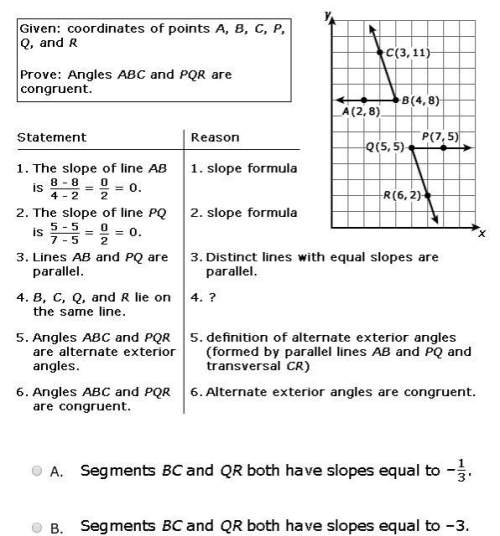
Mathematics, 23.04.2020 23:09 esmeraldavelez63
Why are the solutions to the proportions StartFraction 50 over x EndFraction = StartFraction 10 over 20 EndFraction and StartFraction 10 over 50 EndFraction = StartFraction 20 over x EndFraction the same?
because both result in the equation 20 x = 500, which simplifies to x = 25
because both result in the equation 20 x = 500, which simplifies to x = 250
because both result in the equation 10 x = 1,000, which simplifies to x = 10
because both result in the equation 10 x = 1,000, which simplifies to x = 100

Answers: 3


Another question on Mathematics

Mathematics, 21.06.2019 18:00
Each month, a shopkeeper spends 5x + 14 dollars on rent and electricity. if he spends 3x−5 dollars on rent, how much does he spend on electricity? for which value(s) of x is the amount the shopkeeper spends on electricity less than $100? explain how you found the value(s).
Answers: 2

Mathematics, 21.06.2019 19:00
Solve the problem. a student earned grades of c, a, b, and a in four different courses. those courses had these corresponding numbers of credit hours: 4, 5, 1, and 5. the grading system assigns quality points to letter grades as follows: a = 4, b = 3, c = 2, d = 1, and f = 0. compute the grade point average (gpa) and round the result to two decimal places. 3.40 3.50 8.75 2.18
Answers: 1

Mathematics, 21.06.2019 20:30
At the "no mutants allowed" country farm, every sheep has 4 legs, every chicken has two legs, and all animals have only 1 head. asked to count how many sheep and chicken are in the fields, a farm boy reports back that there are 140 feet and 50 heads. how many sheep and chicken are there? there are sheep and chicken at the farm.
Answers: 1

Mathematics, 21.06.2019 21:30
In a test for esp (extrasensory perception), the experimenter looks at cards that are hidden from the subject. each card contains either a star, a circle, a wave, a cross or a square.(five shapes) as the experimenter looks at each of 20 cards in turn, the subject names the shape on the card. when the esp study described above discovers a subject whose performance appears to be better than guessing, the study continues at greater length. the experimenter looks at many cards bearing one of five shapes (star, square, circle, wave, and cross) in an order determined by random numbers. the subject cannot see the experimenter as he looks at each card in turn, in order to avoid any possible nonverbal clues. the answers of a subject who does not have esp should be independent observations, each with probability 1/5 of success. we record 1000 attempts. which of the following assumptions must be met in order to solve this problem? it's reasonable to assume normality 0.8(1000), 0.2(1000)%30 approximately normal 0.8(1000), 0.2(1000)% 10 approximately normal srs it is reasonable to assume the total number of cards is over 10,000 it is reasonable to assume the total number of cards is over 1000
Answers: 1
You know the right answer?
Why are the solutions to the proportions StartFraction 50 over x EndFraction = StartFraction 10 over...
Questions



History, 10.07.2019 06:50


Health, 10.07.2019 06:50


Biology, 10.07.2019 06:50


Mathematics, 10.07.2019 06:50


Health, 10.07.2019 06:50


English, 10.07.2019 06:50

Mathematics, 10.07.2019 06:50

History, 10.07.2019 06:50

Mathematics, 10.07.2019 06:50




Mathematics, 10.07.2019 06:50





